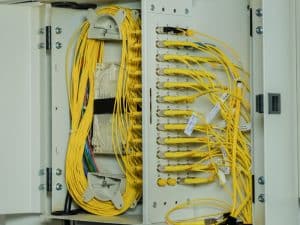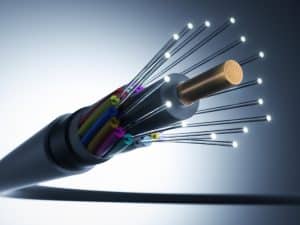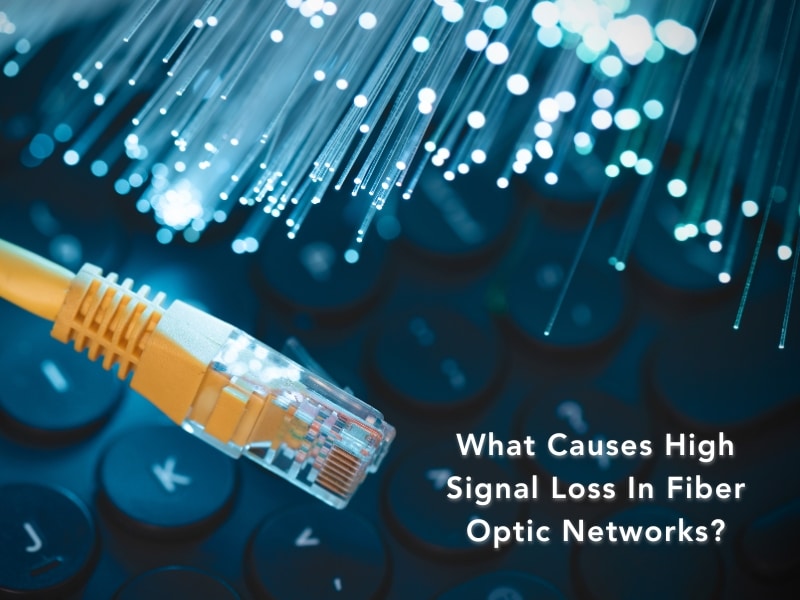Fiber optic networks are the backbone of modern communication systems, delivering high-speed data transmission across vast distances. However, these networks can experience a signal loss, leading to slower speeds, disruptions, or complete failure. Signal loss, also known as attenuation, occurs for several reasons, affecting the overall performance and reliability of the network. Understanding the primary causes of high signal loss in fiber optic networks is essential for homeowners and businesses seeking seamless connectivity, especially in smart homes where multiple devices rely on robust networking.
What are the primary causes of signal loss in fiber optic networks?
Signal loss in fiber optic networks can arise from various factors. Each contributes differently to the reduction in signal strength and overall performance. Below are the most common causes:
- Absorption: In any fiber optic cable, light is absorbed by the glass or plastic material of the fiber. This absorption converts the light signal into heat, resulting in a loss of signal strength. Furthermore, attenuation in fiber optics is a significant factor that can lead to decreased signal quality and network performance.
- Scattering: Light can scatter as it travels through the core of the fiber, especially if the cable material has imperfections. The scattered light does not reach its intended destination, leading to attenuation.
- Dispersion: As light travels through a fiber, different wavelengths may experience varying speeds, leading to a phenomenon known as dispersion. This can result in signal quality issues and reduced performance.
Understanding these causes can help diagnose and prevent performance issues.
How does poor installation affect fiber optic signal loss?
Poor installation practices are a leading cause of signal loss. Incorrect handling and installation techniques can introduce several issues:
- Mismatched connectors: A suitable fiber optic connector can improve transmission. Ensuring compatibility is crucial.
- Dirty connectors: Dust or debris on connectors can block or disrupt the light signal. Proper cleaning procedures must be followed during installation.
- Incorrect cable routing: Improperly routed cables, such as those exposed to tight spaces or sharp turns, can experience stress that may damage the fibers.
Hiring a professional technician is essential to minimize the signal loss caused by installation errors.
Why is fiber bending a significant contributor to signal loss?
Fiber optic cables are designed to be flexible, but excessive bending can still cause significant signal loss. Here are the main reasons why:

- Macrobending: It occurs when a fiber cable is bent too sharply, allowing light to escape from the core. Such bends can reduce the efficiency of signal transmission and lead to attenuation.
- Microbending: Smaller, more subtle bends can also impact signal transmission. These bends are typically caused by external pressure or improper cable placement during installation.
- Bend radius: Every cable has a specified minimum bend radius, the most minor curve the cable can handle without causing signal degradation. Bending the cable beyond this radius increases the likelihood of signal loss.
Signal loss due to fiber bending can be avoided by ensuring proper installation techniques and adhering to bend radius specifications.
How can environmental factors lead to high signal loss?
Environmental conditions play a critical role in the performance of fiber optic networks. Several factors can cause signal loss:
- Temperature variations: Extreme temperature changes can cause the cables to expand or contract, leading to micro bends that degrade signal quality.
- Moisture and humidity: Water infiltration into cables can cause signal loss, especially if the wires are not correctly sealed. Over time, moisture can also corrode connectors and splices, further impacting performance.
- Physical damage: Cables exposed to outdoor elements, such as wind or accidental damage from construction work, can suffer from breaks or fractures.
To mitigate these risks, cables should be installed in protective enclosures or conduits, and regular maintenance checks are essential to ensure that environmental factors do not cause signal degradation.
What role do connectors and splices play in signal loss?
Connectors and splices are critical components in fiber optic networks, and their quality and installation can significantly impact signal transmission. Here’s how they contribute to signal loss:
- Poor-quality connectors: Low-quality or incompatible connectors can cause misalignment.
- Imperfect splices: When fibers are spliced together, any misalignment or gaps between the fiber cores can reduce signal strength. Fusion splicing, which welds the fibers together, generally produces the lowest signal loss, but mechanical splicing may introduce higher losses.
- Connector wear and tear: Connectors can wear out over time, especially in high-traffic areas where cables are regularly connected and disconnected. This wear can result in increased signal attenuation.
How does cable length influence signal degradation?
The length of the fiber optic cable is another crucial factor that affects signal loss. The longer the cable, the greater the chances of signal degradation due to the following reasons:

- Attenuation over distance: Light signals naturally weaken as they travel through the fiber, so the longer the distance, the more significant the signal loss.
- Amplification needs: In long-distance fiber optic networks, amplifiers or repeaters are often required to boost signal strength. These devices are necessary for the signal to maintain usable levels.
- Cable quality: High-quality cables designed for long-distance transmission can reduce the rate of attenuation, ensuring better performance over extended distances.
Selecting high-quality cables and using signal boosters when necessary ensures optimal performance over longer distances.
What are the solutions to minimise the signal loss in fiber optic networks?
Preventing signal loss requires a combination of proper installation, maintenance, and the use of high-quality materials. Here are some solutions to minimize attenuation:
- Use high-quality fiber optic cables: Investing in cables with low attenuation rates can significantly reduce signal loss.
- Ensure proper splicing and connector installation: Skilled technicians should perform splicing and connector installation to ensure minimal loss at these points.
- Adhere to installation guidelines: Follow all manufacturer guidelines regarding bend radius, cable placement, and environmental protection.
- Perform regular maintenance: Routine inspections and cleaning connectors and cables can help prevent issues before they cause significant attenuation.
By implementing these solutions, businesses and homeowners can reduce signal loss and ensure optimal performance in their fiber optic networks.
How can you ensure optimal performance in your fiber optic network?
Ensuring the optimal performance of your fiber optic network involves a proactive approach. Here are vital steps to take:
- Hire certified professionals: Always work with accredited technicians who have the knowledge and experience to design, install, and maintain fiber optic networks efficiently.
- Invest in quality equipment. Using top-tier cables, connectors, and splicing tools ensures minimal signal loss for your network.
- Monitor your network regularly: Implement a monitoring system that allows for the early detection of any issues.
With the right strategy and expert help, your fiber optic network can deliver the high-speed, reliable connectivity your smart home or business needs.
Achieve seamless connectivity with Yakka Technical Services LLC
Yakka Technical Services LLC offers comprehensive fiber optic network optimization. Whether you’re looking to integrate smart home technology or improve the connectivity in your business, their award-winning team is here to help. With network design, installation, and maintenance expertise, our team ensures you experience optimal performance. Contact Yakka Technical Services LLC for fiber optic solutions today to enhance your fiber optic network and keep your home or business connected in the UAE.


